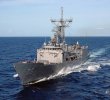Burkes did relatively well in construction because we developed a pretty good idea of what we want them to do, and it fit well in the Fleet design. If you dig back far enough though, they had their growing pains…there’s a reason my first ship was first nicknamed “Always Broke.” Once the design stabilized we got pretty good at building them. And the Fleet actually wanted them enough to let the design go through the growing pains. So I’d agree with Flash…there are some designs we do know how to build. The problem is capacity, which is both about infrastructure and the labor force. Where you have a point, is that we don’t have another labor pool and spare yards to tap to increase capacity. FFG is an example of that…the yards that are stamping ships out for us are tapped out, which in what incentivized us to look for someone new…which has been part of the problem.
LCS, Zumwalt and Ford are examples of ships where the Navy tried to get too fucking clever for its own good. Ford…y’all know plenty about the problem of shoving all the experimental technologies into a ship at once. The first two were designed to requirements and missions that made zero fucking sense, the Navy couldn’t make up its mind what it wanted, and the Fleet hated the idea of what the Navy was pushing. We really should’ve just fucking built more Burkes and FFG7s instead of trying to get cute.
Constellation is a bit different…though some themes repeated. It does actually fit the conventional Fleet design pretty well, in the sense it is at its worst still a shit load better than a FFG7, and the Fleet would immediately know WTF to do with it.
Where Navy did screw up is in signing up for a design requirement that made no sense…forcing it to adopt an “in service” foreign design inspired false confidence, because at a minimum we had to rip out all their weapon systems to incorporate ours. Then someone (Congress?) fucked it even harder because a whole lot of exemptions in the original Euro design from “Buy American” got shit canned, forcing them to swap in additional US mechanical and electrical systems too. I’m not sure who screwed up the survivability standards requiring further redesign. From folks I know - the shipyard didn’t do great either. They apparently didn’t actually expect to win, and weren’t actually ready with enough engineers/architects and skilled technical labor in the yard to actually deliver what they signed up for.
Bottom line, the aviation analogy I would use:
We bought a Eurofighter, then declared we’d be able to rapidly onshore the design to build despite:
1) Needing to replace all the avionics, ordnance systems, and radar/EW with US systems
2) not checking if we could just accept their structural standards…it’d be like taking an AF jet and deciding we needed to beef it up for carrier landings then surprise face - it’s a heavy pig
3) instead of going to an established manufacturer like LM or Boeing, deciding to go to a relatively new startup who had only previously built jet trainers.
3A) after picking the new guys, make it even harder for them by telling them midstream that they need to up the amount of the European design using US parts. So…engines, electrical systems, whatever it takes to hit some arbitrary number




